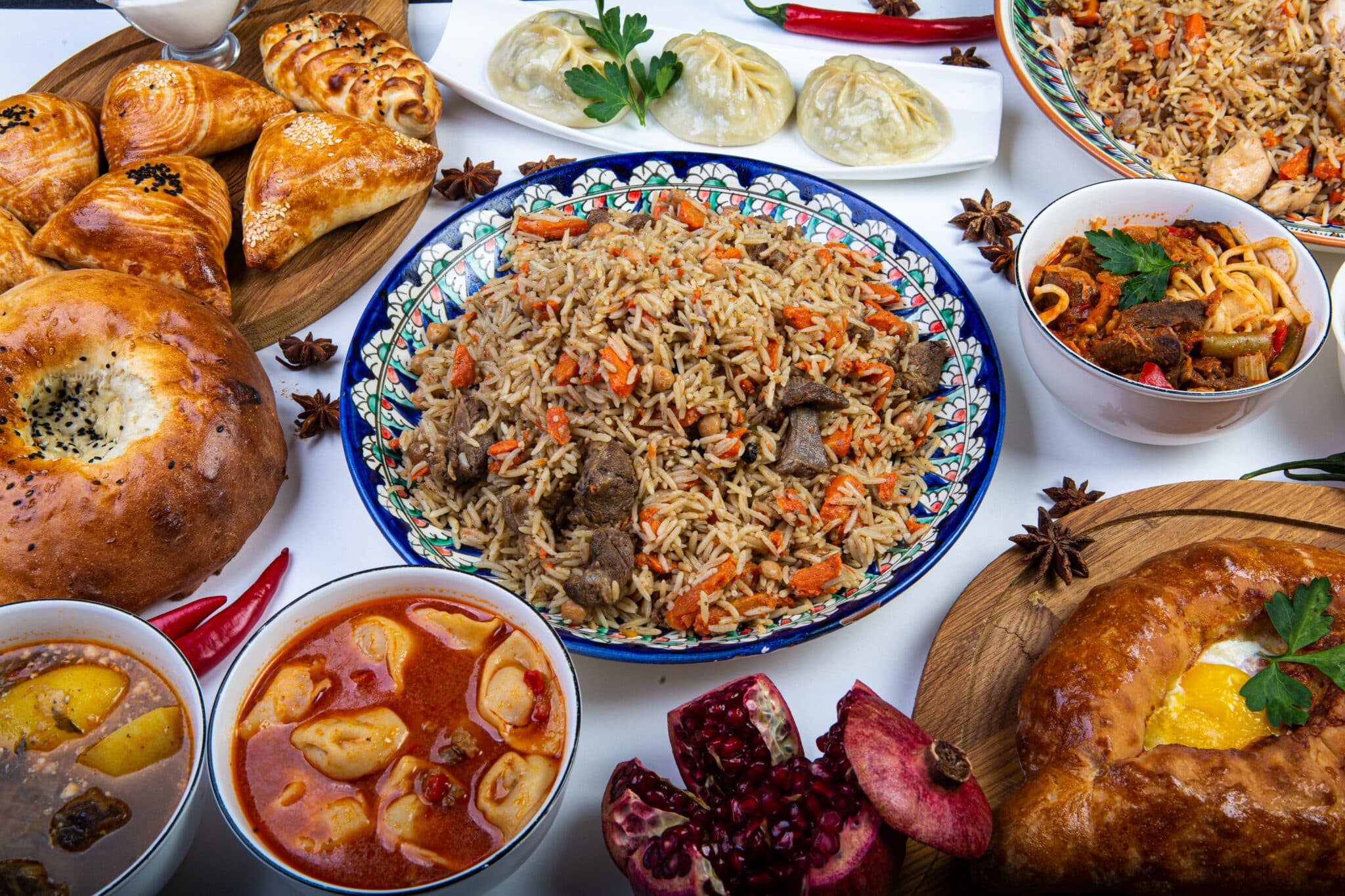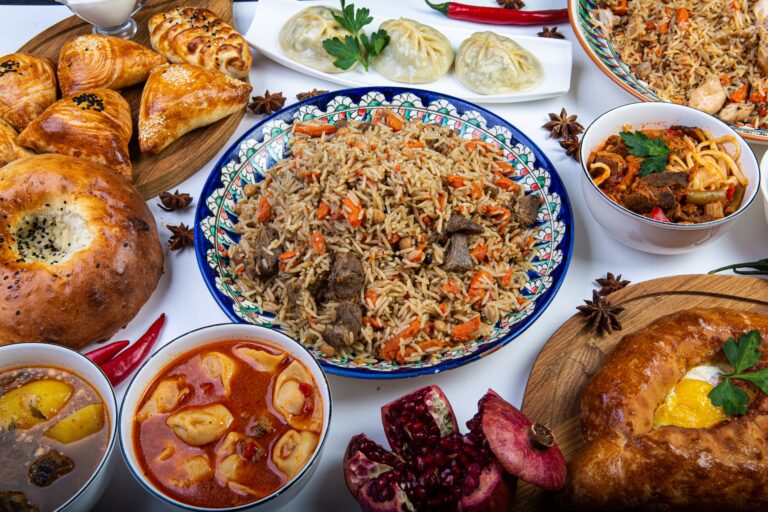
Plov, the national dish of Uzbekistan, is a culinary delight that has stood the test of time. This hearty meal, often enjoyed at gatherings and celebrations, is a testament to the rich cultural heritage of this Central Asian nation.
Positioned at the crossroads of the Silk Road, Uzbekistan played a crucial role as a meeting point for a wide array of cultures and trade routes, naturally leading to a blending of culinary influences. Plov is intricately tied to the nomadic customs of Central Asia, where it served as a substantial, all-encompassing meal for both travelers and warriors.
For all the fans of international food, our team at Remitly created this guide as part of our series that celebrates the cuisine of people around the world.
The History of Plov in Uzbekistan
The origins of plov are deeply rooted in history, believed to have been introduced by nomadic tribes that traversed the region centuries ago. These early settlers relied on simple yet nourishing meals that could be easily prepared over an open fire.
As time passed, plov evolved into a cornerstone of Uzbek cuisine. Its popularity surged as it was passed down through generations, giving rise to various regional variations.
Some renditions may incorporate dried fruits such as raisins or apricots to introduce a touch of sweetness, while others might integrate vegetables like chickpeas or peas for added texture and flavor. In certain areas, plov takes on a distinctive character by using fish instead of meat, reflecting the local dietary preferences and ingredient availability.
Despite these differences, the essence of plov remains consistent—a hearty, flavorful dish that embodies the country’s hospitality, sense of community, and identity.
Ingredients and Cooking Process
In a traditional plov recipe, you’ll find a combination of rice, meat, carrots, onions, and spices, each playing a pivotal role in shaping the dish’s distinctive flavor profile.
Rice serves as the satisfying foundation, while the choice of meat, typically lamb or beef, contributes depth and richness. Carrots contribute a touch of sweetness and vibrant color to the dish, while onions infuse it with an aromatic kick. Spices like cumin and coriander impart warmth and complexity to every bite.
Preparing plov is indeed an art form that demands both patience and precision. It begins with browning the meat in oil until it acquires a rich, golden crust. Following that, onions and carrots are sautéed until they reach a tender, caramelized state.
The next step involves introducing the rice directly into the pot, along with water or broth for the cooking process.
As all these elements simmer together over low heat, their flavors gradually meld, producing a one-pot wonder that’s not only deeply comforting but also incredibly delicious.
A Simple Recipe for Uzbek Plov
Plov is a dish that’s as enjoyable to prepare as it is to eat. Here’s a basic recipe you can try at home.
Ingredients:
- 2 cups of long-grain rice
- 1 pound of lamb or beef, cut into chunks
- 4 large carrots, peeled and julienned
- 2 large onions, finely chopped
- 4 cloves of garlic, minced
- 1 teaspoon of cumin seeds
- 1/2 teaspoon of coriander seeds
- Salt and pepper to taste
- Vegetable oil for frying
Instructions:
- Rinse the rice under cold water until the water runs clear. Set aside.
- Heat oil in a large pot over medium heat. Add the meat and brown on all sides.
- Add onions and garlic to the pot and sauté until they become translucent.
- Stir in carrots and continue cooking until they soften.
- Sprinkle cumin, coriander, salt, and pepper over the mixture.
- Add the rinsed rice on top, but do not stir it in yet.
- Pour enough water or broth into the pot to cover the ingredients by about an inch.
- Cover the pot with a lid and let everything simmer on low heat for about an hour, or until rice is fully cooked.
- Once done, gently mix everything together so that flavors are evenly distributed.
Remember: patience is key when making plov—the longer it cooks, the better it tastes!
Serving and Eating Customs
Plov is typically served in large communal dishes, symbolizing unity and togetherness. It’s often enjoyed with hands, further emphasizing its communal nature. Prior to eating, it’s customary to utter “bismillah” (in the name of God), expressing gratitude for the meal.
Plov holds a significant role in Uzbek celebrations and festivals. It is often prepared on special occasions like weddings or birthdays, and new year, symbolizing prosperity and good fortune.
The Cuisine of Uzbekistan
Uzbek cuisine offers a diverse array of dishes that reflect its rich cultural heritage.
Bread: The Heartbeat of Uzbek Cuisine
Bread—or non—is central to every meal in Uzbekistan. It’s frequently baked in tandoor ovens, resulting in round loaves with crispy crusts and soft interiors. Non is considered sacred and is never wasted or thrown away.
Soups and Stews
Uzbek soups and stews, like shurpa and mastava, are hearty affairs filled with meat, vegetables, and legumes. They’re typically enjoyed with a side of non.
Samsa: A Savory Treat
Samsa is a popular street food in Uzbekistan. These flaky pastries are typically filled with minced meat or vegetables and baked until golden brown.
Manti: Dumplings with a Twist
Manti—large dumplings filled with spiced meat or pumpkin—are another favorite. They’re usually steamed and served with sour cream or yogurt.
Shashlik: Grilled to Perfection
Shashlik—skewered and grilled meat—is an Uzbek barbecue staple. It’s marinated for hours before being cooked over hot coals to achieve its signature smoky flavor.
Whether you’re sampling plov or biting into a samsa, you’re experiencing a piece of Uzbek culture—one delicious bite at a time.
Visit the homepage, download our app, or check out our Help Center to get started.
